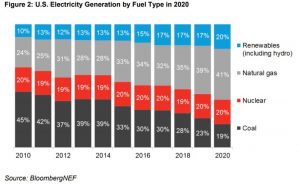It’s that time of year! The Business Council for Sustainable Energy (BCSE) by BloombergNEF has produced the 2021 Sustainable Energy in America Factbook, its annual coverage of the previous year’s data on the energy marketplace. As with most topics coming out of 2020, the report portrays a year of disruption that manages to highlight some bright spots yet warns of the need for innovative thought about the future. A comprehensive guide, this report deserves a comprehensive read. However, we thought we’d share a few of the key points.
Natural gas and renewable generation continued to expand their share of the resource mix.
A record 33.6 GW of wind and solar capacity was added to the grid this year.
The 2020 sustainable energy marketplace took some hits, many a result of the COVID pandemic.
- After beginning 2020 with more than three million jobs in the U.S. clean energy sector, the year ended with the lowest number of workers since 2015, with 400,000 clean energy jobs lost or furloughed during the pandemic.
- The need to upgrade infrastructure came into greater focus in 2020 due to an estimated $95 billion in damages from natural disasters such as volatile storms and wildfires. Moving forward, increasing the resilience of the U.S. infrastructure against such situations must include modernized clean energy solutions such as microgrids and digital solutions.
- Companies signed fewer contracts in 2020 to buy clean power. Corporate power purchase agreements (PPA) for wind/solar slowed to 11.9GW due to pandemic worries.
2020 clean energy sectors proved strong resilience despite setbacks.
- U.S. clean energy continued its decade-long growth trend.
- Renewable energy build set a record in 2020, adding 33.8 GW of capacity, up 61% from 2019.
- Power from all zero-carbon sources (renewables plus nuclear power) set another record, meeting 40% of demand, despite a decline in nuclear output.
- In 2020, nearly two-thirds of the U.S. population lived in jurisdictions with modern building energy codes, with 69% of the population covered by residential codes and 74% by commercial codes.
- Corporate decarbonization commitments grew. 65 companies joined the RE100 initiative to expand renewables use, 59 joined EP100 pledging to improve energy productivity.
- Total U.S. emissions sank 9% to end 2020 20% below 2005 levels, putting it on track to meet its Paris Agreement goal. Caveat: Unfortunately, this is likely short-lived as the pandemic is responsible. 2021 emissions will rebound with economic recovery.
So, did the push to focus on sustainable energy take some hits in this country and throughout the world? Naturally. Still, the big picture is not discouraging. BCSE President Lisa Jacobson puts it this way: “The continued growth of clean energy in the United States, in spite of the economic downturn and the challenges of the pandemic, demonstrates that the market for these technologies is maturing and the portfolio is highly resilient.”
Want to know more? Read the 2021 Sustainable Energy in America Factbook.
At Building Performance Equipment, Inc. and Haglid EngineeringTM, we’re certainly not discouraged by the data from 2020. We stand ready to continue the energy recovery innovations in technology and design that we are known for. Want to be part of the solution in 2021? We’re happy to be a helping hand. Just give us a call.

